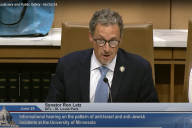You have /5 articles left.
Sign up for a free account or log in.
Absent a national standard for how higher education institutions should report COVID-19 cases on their campuses, many colleges have taken to publishing information on cases on online dashboards. But observers say the dashboards vary greatly in terms of completeness and transparency. A lack of transparency or completeness can deprive students, employees and families of crucial contextual information they need to make decisions about their safety and make it hard to make comparisons across institutions.
“I think different states, state departments of health and state legislators really could play a role in advocating for what is the expected minimum amount of transparency that colleges and universities in their state should be putting out,” said Cary Gross, a professor of medicine and epidemiology at Yale University and co-founder of We Rate COVID Dashboards, a website and associated Twitter account that grade university dashboards based on nine criteria.
The best dashboards, according to the We Rate COVID Dashboards rating scheme, are updated at least once every weekday and include information not only about the positive number of cases but also about the total number of COVID tests conducted and the frequency of testing. Dashboards that break down case data for students and faculty/staff separately, and provide information on trends in the surrounding city or county, the number of individuals in isolation/quarantine, and the campus’s operating status, among other elements, are also superior, according to the website's metrics.
Dashboards are very much works in progress. As the fall semester has gotten underway, some colleges have tweaked their databases, adding additional sources of information, or increasing the frequency of updates from weekly to twice weekly, or from weekly to daily.
Ohio State University earned an A-plus from We Rate COVID Dashboards, while colleges earning A grades include Colgate, Harvard and Tulane Universities; Bryn Mawr and Vassar Colleges; Wheaton College, in Massachusetts; and the University of Colorado at Boulder.
“Over all, as the public health impact of colleges reopening has become apparent, there has been a substantive move towards greater transparency,” Gross said. “Our hope, with rateCovidDashboard.com, is to provide suggestions, to applaud colleges that are making strong efforts to clearly share their COVID testing strategies, status and outcome, and to call out colleges and universities that could be doing a better job.”
Differences can be seen across different state systems. The State University of New York has created a centralized dashboard for all 64 of its institutions, updated daily. Although SUNY institutions may separately have their own dashboards, the centralized approach means the same basic level of information about case numbers, total tests administered by the campus and the percentage of positive tests, quarantine capacity and hospitalizations and fatalities is available whether you attend or work at a major research university or at a smaller four-year institution or community college.
Other systems have left it to individual campuses to create their own dashboards. A spokesman for the University System of Georgia, Lance Wallace, said for example that system administrators instructed universities to "provide information they feel is most appropriate for their campus community … With 26 institutions, ranging in size from a couple thousand students to more than 53,000, it makes sense for each to tailor its reporting approaches to their specific circumstances."
Matthew Boedy, an associate professor of rhetoric and composition and president of the Georgia Conference of the American Association of University Professors, has tracked case numbers across Georgia colleges and universities. He said that while he believes every institution is publicly sharing at least some data, the level of detail varies greatly.
For example, Georgia's Kennesaw State University, a research university that enrolls more than 40,000 students, only includes aggregate information on total weekly case numbers within a FAQ section on its website: “During the week of September 26 to October 2, there were 49 reported cases of COVID-19,” the website stated when accessed Wednesday. “Please note that this number includes individuals working or studying remotely.”
Kennesaw State officials did not respond to several inquiries about whether there is any other place other than the FAQ where the university is publicly sharing information about case numbers.
“It is a wide variety of data releases, some that are inconsistent and laughable compared to other schools’,” Boedy said.
Another area of variation is in how frequently institutions are testing their students and how much data are being collected as a result to feed into any dashboard.
Emily Rounds, a senior at Davidson College, in North Carolina, is co-chief of operations for the College Crisis Initiative, a research effort that just finished collecting information on COVID testing procedures at about 1,400 institutions; the analysis found that only a quarter of colleges are routinely testing some portion of their students through surveillance testing.
“I found that a lot of schools did have dashboards -- I was pleasantly surprised -- but at the same time there is this issue of surveillance testing,” Rounds said. “A lot of schools are saying they’re doing surveillance testing in terms of random testing or they take a certain percentage of their student body per day or per week to test. The problem with that is a lot of institutions have not posted the percentage of students they are testing per week or how many students are actually showing up.”
"To understand an institution’s plans and protocols, you have to dig deep," Rounds said.
Testing protocols across universities vary widely, as do reporting procedures. In August, three Democratic senators -- Elizabeth Warren, of Massachusetts; Chris Murphy, of Connecticut; and Tina Smith, of Minnesota -- wrote to the heads of the U.S. Department of Health and Human Services and the Centers for Disease Control and Prevention raising concerns about the lack of national standards for reporting of COVID cases linked to colleges. They argued that the status quo, which relies on voluntary reporting by colleges, "is likely to create a patchwork of inconsistent information across states, localities, and the nation, undermining transparency and efforts to address the pandemic."
A spokeswoman for Warren’s office said the federal health agencies did not respond to the letter, which requested answers to a series of questions by Sept. 2.
The CDC and HHS did not respond to requests for comment.
“It’s an interesting point that we’re into October and the closest we have to best practices and guidelines comes from We Rate COVID Dashboards' Twitter account rather than from any central organization,” said Teresa Valerio Parrot, principal of TVP Communications, a higher education communications and marketing firm, and a blogger for Inside Higher Ed.
“So many COVID dashboards have been created for purported transparency, but many do little to help communities understand real-time community risk, and they create less comfort and understanding across the campus,” Valerio Parrot said. A good college dashboard should feature timely updates and information on when it was last updated, information on isolation/quarantine capacity, definitions of terms and data on community rates, she said.
Valerio Parrot said institutions are nervous about sharing information on dashboards for several reasons.
"If they currently have low COVID rates, I think they worry about what it will look like should they have an increase in cases and how that could create fear and concern in the community. I think there are some institutions that are concerned about how their number of cases will appear compared to their peers’, and they're worried about being lumped in with some institutions that have had high positive rate. And I think there are a number of institutions that haven’t had to have great transparency for data prior to COVID and they’re catching up to what public accountability feels like, and how much vulnerability they’re willing to take on in sharing that information."
Still, many colleges understand that they are responding to a real need with their dashboards and continue to develop and improve them, said Gross, the Yale medical professor who co-founded We Rate COVID Dashboards. He noted that his group has already issued re-ratings for 40 different institutions that made changes to their dashboards after the semester started.
"I think there’s really a desperate need for this information," he said. "I have two kids in two different colleges right now. I sure look at the dashboard."








